Sky
THE AIR SHOW IN KALEMEGDAN AND THE AIRCRAFT MUSEUM IN SURČIN
Fear of Not Flying
Admiring bravura on the long-expected aero-show, making real miracles in the sky, we had many questions and we had to find the right answers. So many history and generations, so much courage and inspiration, so much knowledge and denials, so many unusual destinies and great persistence are needed to reach a day like that and moments like those! How many of us know that among the pioneers were one municipality employee and one photographer, or that the 100th anniversary of aviation in Serbia is celebrated?
By: Nevena Mihajlović
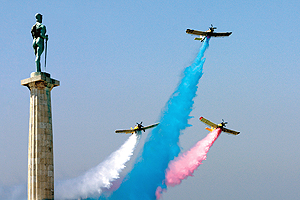 On the old fortress, in the golden autumn, many people were standing, gazing at the sky, breathless. Old and young people, men and women, locals and newcomers. One could often hear a sigh of admiration. The reporters of National Review were not left indifferent, as well. On the old fortress, in the golden autumn, many people were standing, gazing at the sky, breathless. Old and young people, men and women, locals and newcomers. One could often hear a sigh of admiration. The reporters of National Review were not left indifferent, as well.
The bright and clear sky, so unusual for the month of November, the long-announced air show was now finally on: old two-engine crafts, serious and dressed up as village householders as for Sunday church, were writing a message in the sky with the smoke in the colours of the Serbian flag. The message was so dear to those who knew how to read it. Pilots and airplanes from the famous group ”Zvezda” made miracles in the sky, as well as the pilots of the Serbian Military Aviation on fighter planes of Serbian and Russian production. Is this real or is this our imagination: above the Danube and the forests, on the left coast, a vertically standing plane is flying aside?! The airliner ”Boeing”, followed by airplanes of the Serbian army, flying above the city, finding its place among its symbols, on an unforgettable picture...
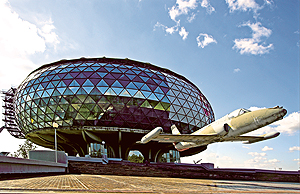 So many history and generations, so much courage and inspiration, so much knowledge and denials, so many unusual destinies and great persistence are needed to reach a day like that and moments like those! So many history and generations, so much courage and inspiration, so much knowledge and denials, so many unusual destinies and great persistence are needed to reach a day like that and moments like those!
Answers to all of these questions can be found in one place in Belgrade, in the Aircraft Museum, and all curious people head there after the aero-show. The Serbian Aircraft Museum, the most important of the kind in the Balkans, stands besides the Belgrade Airport ”Nikola Tesla”. For showing all of its objects, a place three times bigger than the Belgrade airport still would not be enough. However, the original installation of the Museum, on six thousand square meters has a very good concept. For visitors whose number will raise until 2010 to one million this is a true journey through time.
FROM THE FIRST LOST BATTLE
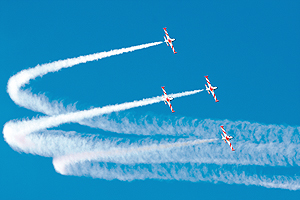 The building of the Museum was intentionally built. The shape of the ”landing airplane wheel” was made after the project of Ivan Strauss who won a competition in the beginning of the 70’s of the 20th century. The building of the Museum was intentionally built. The shape of the ”landing airplane wheel” was made after the project of Ivan Strauss who won a competition in the beginning of the 70’s of the 20th century.
A whole team of custodians is leading us through the exhibition. Every custodian is a specialist for a certain field, and their stories interlace and finally uniting in a whole.
The round tour begins with the dummy of the first airplane which flew over Serbia, and it was constructed by a community employee Ivan Sarić. This great adventurer had a great opportunity in France to secretly photograph an airplane in which Louis Blaireaux flew over La Manche. When he returned to Serbia, after constructing his own car (his wife was driving it and she was the first woman in Serbia with a driver’s license), he made an airplane with a carpenter. The tools they used are a part of the exhibition as well. The pilot’s seat was a garden chair with cut off easel, the fuel reservoir was made out of a milk can, and wheels from a velocipede. It was only seven years after the Wright brothers flew with their own airplane.
One year later, in front of many spectators, in Kalemegdan (as today), the second aircraft was tested. Its constructor was Mihail Merćep, who was a photographer. However, this aircraft lost the battle with fire on its first taking off. One part of this aircraft is the first and the oldest object in the Aircraft Museum.
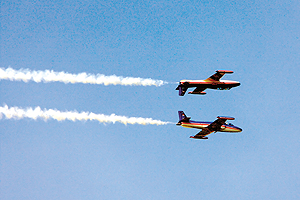 – The son of Branislav Nušić, Strahinja, took part in this event and he preserved a part of the plane’s wing and that is how he started collecting objects for the museum. Today, this part is preserved in a safe, under special conditions – says Mirjana Novaković, the custodian charged with the history of civil aviation. – The son of Branislav Nušić, Strahinja, took part in this event and he preserved a part of the plane’s wing and that is how he started collecting objects for the museum. Today, this part is preserved in a safe, under special conditions – says Mirjana Novaković, the custodian charged with the history of civil aviation.
After this pioneer part, the exhibition continues with the period before World War I. Among maps and documents dominates the photograph of Commander Radomir Putnik, deserving for the existence of the Aircraft Command in Serbia. There is also the famous photo of Mihajlo Petrović, the Serbian pilot who was brought down above Skadar in 1913 and he became the first victim of war aviation, then data about the withdrawal across Albania, the Serbian-French escadrille...
– Displayed airplanes had a wooden construction, which can be determined only if you knock the wing. One can also see training, military, civil, sport and acrobatic crafts. Domestic and foreign. Bought, forgotten, obtained in exchange – says Mirjana Novaković. – The German ”Messerschmitt” is one of the four plane types which were used during World War II. The fact that this craft was so powerful is witnessed by the fact that the German pilot Erich Hartmann won 350 victories in air battles.
THE SPEED OF ”ORIENT EXPRESS”
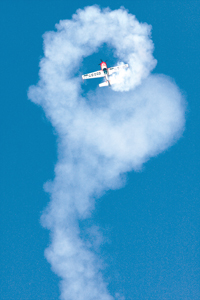 While the exhibition host is naming the crafts, we can mark abbreviations, numbers and names of birds. Every abbreviation marks the intent of the plane, the numbers marks the series and the bird marks its shape. ”Stork” got its name for its long landing gear which provides quick action while landing and taking off. ”Pike”, the notorious airplane which was used in bombing of Belgrade, in 1941, has a curved beak. ”Nosed swordfish” looks scary not for its ”shark shape” but for the 24 rockets that is carries, the glider is the ”cat”. We also have the domestic ”seagull”, ”hawk” and the ”eagle”, cognoscible for its pitot-tube which is used for speed measuring. While the exhibition host is naming the crafts, we can mark abbreviations, numbers and names of birds. Every abbreviation marks the intent of the plane, the numbers marks the series and the bird marks its shape. ”Stork” got its name for its long landing gear which provides quick action while landing and taking off. ”Pike”, the notorious airplane which was used in bombing of Belgrade, in 1941, has a curved beak. ”Nosed swordfish” looks scary not for its ”shark shape” but for the 24 rockets that is carries, the glider is the ”cat”. We also have the domestic ”seagull”, ”hawk” and the ”eagle”, cognoscible for its pitot-tube which is used for speed measuring.
We can see the ”Hurricane” and ”Spitfire”, the airplanes which saved the British Islands during the Great War and later produces in the Serbian ”Zmaj” factory. We can also see some prototypes of domestic airplanes, like the one with the mark ”451”, interesting for the fact that the pilot is supposed to lye on his stomach. However, it was quickly determined that the head position would stop the blood float so the idea was never accomplished.
– During the war, there was produced about four thousand ”Jak-3” Russian airplanes, and the Serbian plane is the only one saved in total. The similar situation is with Serbian ”Ikarus” models of which the only exemplars are preserved in our Museum.
The interesting fact is that the Russian fighters were constructed by women, even two planes a day. Women also aviated the airplanes ”Polikarpov 2”, manually throwing bombs on Germans. ”IL2”, called ”the flying tank” was the first one shelled in steel. We can also find some American airplanes in this collection, which were delivered as military help.
– Most of the objects could fly again, with good repair. They have all needed parts, and many of them have preserved their original machine guns, rockets, bombs... Of course, everything dangerous had been removed...
The first aviation company was established in 1927. it was called ”Aeroput”, the precursor of JAT. Its founder and manager was the pilot Tadija Sondermajer who flew from Paris, via Belgrade and Constantinople to Bombay in two weeks in order to emphasize the importance and security of flying. Sondermajer will be remembered for his duel with the writer and poet Miloš Crnjanski, who was also a passionate pilot. Fortunately, no one got hurt, and the reasons for the duel were airplanes, of course.
After World War II, on the relation Paris-Belgrade-Constantinople flies a French-Romanian company. The flight lasted forty hours, almost as the drive on the ”Orient Express”. That was the time when the first night flight was introduced from Belgrade to Bucharest from the airport in Pančevo, but the idea did not survive. The airport was on the location of the present ”Airport City” in Novi Beograd. The administration building is gone but the hangar is still there.
THE FIRST HUNDRED YEARS
 – After World War II, airplanes were used in therapeutic purpose. Children who suffered from pertussis flew in planes on a certain height, instead of spending time in a hyperbaric chamber. – After World War II, airplanes were used in therapeutic purpose. Children who suffered from pertussis flew in planes on a certain height, instead of spending time in a hyperbaric chamber.
In the part of the Museum dedicated to the development of JAT there are photographs of the modern hangar, training space, technical and cargo departments, offices but also planes such as ”DC3”, ”DC9”, ”DC10”, ”Boeing 727”. In the 90’s we only flew with rented planes. Not one ”DC9” is left complete and the museum exemplar of ”DC10” would take a lot of space in front of the building, given that it is 35 meters wide and long.
The story ends with the pride of modern Serbian airplane industry, the fighter plane ”seagull”. Its beak is directed to the cabinets with parts of planes which were brought down: ”F 16” (an eagle on one of its wings means that it was aviated by the escadrille commander) and ”F 17 Stealth” (the only one ever brought down) and also with an unexploded rocket ”tomahawk” (one of 1200 fired) and pilot less missiles. We can also see the tail part of ”super seagull” which was aviated by Branislav Nenovski, a Macedonian pilot. He was shot above Lika and he succeeded to land on the Udbine airport thanks to the good plane construction, where its damaged part was repaired. We do not know what happened with the plane but Branislav still aviates.
– On the upper floor we can see one parachute, but no paragliders, kites, balloons... we plan to expand our exhibition. Our gliders achieved great results, even won world championships. Among the objects we can see the winning glider ”Košava”.
Air transportation in Serbia developed together with world progress, but its raise was later interrupted. Jet planes were our first products, and we later imported them. Projects for super-sonic airplanes are prepared but we still do not have the means for their production. As for the Museum, we are preparing many events during 2009 to mark the 100th anniversary of Serbian aviation.
***
Children and Travolta
The Museum owns 200 crafts (mostly in its depot), about 100 aero-motors, instruments, training simulators, photographs... It has its own library, archives, theatre hall and space for exhibitions.
– Children find this place really interesting. During their visit, we play them movies, we let them aviate the airplane ”Utva 66”, the visit the flight control cabin, and they can see watch a plane taking off. We get calls from people who wish to repair old-timers or to buy ”seagull 2” from us as the Hollywood super-star John Travolta did – says Igor Marjanović, the custodian and pedagogue in the Museum.
***
War and peace
– After world wars, military pilots aviated civil planes- says Zoran Milićević, the Manager of the Aircraft Museum, for National Review. – I also aviated some crafts form our present collection, even 16 different models.
***
When and how
The working hours of the Aircraft Museum are every day from 09:00 am to 03:30 pm (to 06:30 pm, during the summer season). One can reach it on the highway (following the road to the airport) of on the bus 72 which operates from Zeleni venac via Ledine and Surčin. The tickets cost 150 and 180 Dinars (depending on the visitor’s age) and group visits can get 20 percent discount.
|
